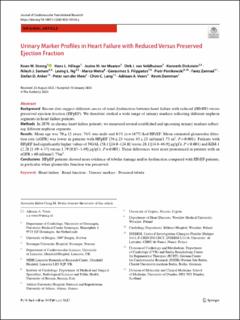Urinary Marker Profiles in Heart Failure with Reduced Versus Preserved Ejection Fraction
Streng, Koen W.; Hillege, Hans L.; ter Maaten, Jozine M.; van Veldhuisen, Dirk J.; Dickstein, Kenneth; Samani, Nilesh J.; Ng, Leong L.; Metra, Marco; Filippatos, Gerasimos S.; Ponikowski, Piotr; Zannad, Faiez; Anker, Stefan D.; van der Meer, Peter; Lang, Chim C.; Voors, Adriaan A.; Damman, Kevin
Journal article, Peer reviewed
Published version

Åpne
Permanent lenke
https://hdl.handle.net/11250/3091337Utgivelsesdato
2023Metadata
Vis full innførselSamlinger
- Department of Clinical Science [2318]
- Registrations from Cristin [9791]
Originalversjon
Journal of Cardiovascular Translational Research (JCTR). 2023. 10.1007/s12265-023-10356-ySammendrag
Background
Recent data suggest different causes of renal dysfunction between heart failure with reduced (HFrEF) versus preserved ejection fraction (HFpEF). We therefore studied a wide range of urinary markers reflecting different nephron segments in heart failure patients.
Methods
In 2070, in chronic heart failure patients, we measured several established and upcoming urinary markers reflecting different nephron segments.
Results
Mean age was 70 ± 12 years, 74% was male and 81% (n = 1677) had HFrEF. Mean estimated glomerular filtration rate (eGFR) was lower in patients with HFpEF (56 ± 23 versus 63 ± 23 ml/min/1.73 m2, P = 0.001). Patients with HFpEF had significantly higher values of NGAL (58.1 [24.0–124.8] versus 28.1 [14.6–66.9] μg/gCr, P < 0.001) and KIM-1 (2.28 [1.49–4.37] versus 1.79 [0.85–3.49] μg/gCr, P = 0.001). These differences were more pronounced in patients with an eGFR > 60 ml/min/1.73m2.
Conclusions
HFpEF patients showed more evidence of tubular damage and/or dysfunction compared with HFrEF patients, in particular when glomerular function was preserved.
